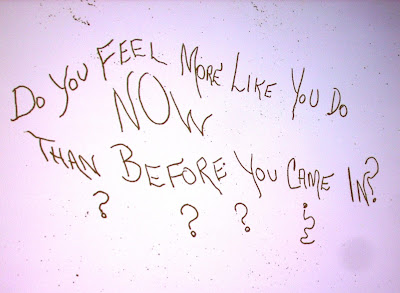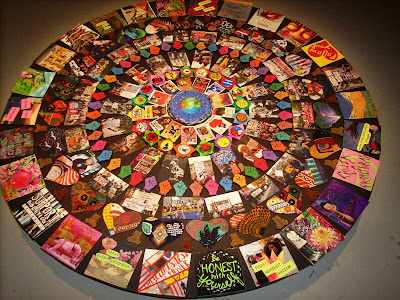When I
heard that this year’s Older Americans Month theme was “Age Out Loud,” I thought about the relatively loud Baby Boomer Generation (born 1946-1964),
which followed the Quiet Generation (born 1925-1945) and came of age during the
Free Speech Movement (student leader Jack Weinberg, at age 24 in 1964,
infamously advised, “Don’t trust anybody over 30”),
Gathering of Tribes for a Human Be-In (its press release announced “a new nation has grown inside the robot flesh of the old”) and Summer of Love.
Some of
my Older American shut-in clients came to San
Francisco
San
Francisco Arts Commission’s Art on Market
Street
Hippie Modernism:
The Struggle for Utopia
“It is
possible that it is possible … Take the no out of now then…” Berkeley
Arts Museum
The Diggers came out of San Francisco Mime Troupe (anarchist guerrilla street theater group)
based in Haight-Ashbury . Their 1% Free (1967) poster, designed by Digger
Peter Berg and showing two Chinese tong men waiting beneath the Chinese character for “revolution,”
suggested that Free people were a minority. Hippies from the 1960s were predominantly white, middle-class youth.
The Diggers’ agenda was to create a
Free City,
by putting free before any word: food,
store, shelter, healthcare, entertainment, etc.—viewed as human
rights instead of commodities. This
challenged “business as usual” because doing things for free (and anonymously)
could not be co-opted, and transformed the audience to participants who could
be free themselves! Why wait for retirement to drop role-playing “employee” and
become “life-actor”? As Digger Peter Coyote
explained in his memoir, Sleeping Where I
Fall (1998), “If you wanted to live in a world with free food, then create it and participate in it. Feeding
people was not an act of charity but an act of responsibility to a personal
vision.”
Starting Fall 2017, Free City College Program is a 2-year pilot program offering free tuition to San Francisco residents!
Starting Fall 2017, Free City College Program is a 2-year pilot program offering free tuition to San Francisco residents!
Psychedelic
posters break all the print design rules for seniors:
- use simple, easy-to-read
typefaces
- avoid long blocks of text
- incorporate lots of white
space to reduce eye fatigue
- keep use of italics to
minimum
- maintain high contrast
“We are
all handicapped … what the people really NEED” from
This 1973
Community Memory terminal,
set-up at Leopold’s Records in Berkeley
de Young
Museum hosted a panel discussion, Reflecting the Love Generation with curators Jill D'Alessandro (textile arts) and Colleen Terry (graphic arts) in
conversation with music
historian Dennis McNally and music journalist Joel Selvin,
contributing authors to the catalogue for The Summer of Love Experience: Art,
Fashion, and Rock & Roll. They discussed free spirits drawn to San
Francisco during the Summer of Love after reading Jack Keroauc’s On the Road, and the draft during
Vietnam War as impetus for the Summer of Love’s philosophy of peace and love.
de Young's exhibit website includes digital stories that provide historical and cultural context: The Beginnings of the San Francisco Sound; Trips
Festival; Awakening in the Park; Music and Dance Venues; Posters; Idealism on
Haight; Levi’s: Practicality and Ideology; Politics; and Legacy.
“Don’t trust anyone over 30” and gentle reminder "Be nice to each other."
The Summer of Love Experience attracted all ages, from Hippies to
Hipsters.
On the Road to the
Summer of Love
On the 50th
anniversary (May 13) release of “San Francisco (Be Sure to Wear Some Flowers in
Your Hair),” Summer of Love anthem sung by Scott McKenzie,
California Historical Society (CHS) offered free admission to visitors wearing
flowers in their hair.
On the Road to the Summer of Love exhibit was curated by Dennis
McNally, former publicist of the Grateful Dead.
Human Be-in was
organized in response to a new law in California
Summer of Love in Tenderloin
The Diggers' "Invisible Circus" Remembered as a 72-hour “environmental community
happening” at Glide
Church
Participants were
invited to “do your thing, be what you are … Anyone who wants to can shape
history … Those who do not create the future are required to endure the future
of those who do."
“Do you feel more like you do now than before when you came in?”
Shaping San Francisco
David Talbot discussed Summer of Love, Season of the
Witch, and the Tenderloin. In Season of the Witch (2012), David wrote that
the Diggers’ women did the “grunt work that kept it all going.” While the Diggers’ act of giving away free was performance,
lasting institutions resulted from “do it ourselves” ideas like Huckleberry
House for teenage runaways when it was against the law and Haight-Ashbury Free Clinic stood
for healthcare as a right, not privilege.
The Diggers’ "feed-in" actions at City Hall were meant to “affirm responsibility”–to do what City government should. As
hard drugs took over, hippies left for communes or intentional communities; today, San Francisco
Women of the ‘60s Counterculture: Planting the Seeds of Liberation
At the San Francisco Public Library, CHS Public
Programs Manager Patricia Pforte introduced Women of the ‘60s Counterculture: Judy Goldhaft, Salli Rasberry,
Delia Moon, Denise Kaufman, Alexandra Jacopetti Hart, and Gretchen
Lemke-Santangelo (moderator). They
shared personal stories of how growing up in dominant 1950s culture (Father Knows Best, misogyny, repression)
created path to counterculture’s values (self-expression, living simply,
everything free), the role of psychedelics in shaping values (“lies of older
generation” that smoking pot was dangerous, LSD opened to multiple
realities/possibilities/creativity/feelings of nature, etc. yet made illegal).
SOMArts hosted this month’s exhibition, Shifting Movements: Art
Inspired by the Life & Activism of Yuri Kochiyama (1921-2014) with Passing It On: Other
Feminist Futures Panel.
With refreshments
provided by People’s Kitchen Collective, the discussion reflected on Yuri’s legacy: radical hospitality, leadership as relationship building, solidarity between communities
(Asian and Black), intergenerational knowledge sharing, womanism, etc.
Consciousness = power. Individual clouds are separate but create formations and communities together, pushed together and apart by winds of social change that cannot always control.
Consciousness-raising identity in response to "othering"
Yuri cradled Malcolm X after his assassination in 1965
Yuri’s advice through her ages on T-shirts: "decolonize your mind" and "ultimate objective in learning anything is to try to create and develop a more just society."
Resistance & Compassion (2017) mandala by Nancy Hom
Building Community
San Francisco Main Library hosted Digital Inclusion Week, May 8-13, 2017, which included Tech Expo, Life Got Wider: Meanings Associated with the Computer Use of Older Adults exhibit, and Cyber-Seniors documentary screening.
May 16, 2017 Senior & Disability Rally at City Hall called for funding more home
and community services, such as rental subsidies, IHSS retention pilot, internet access, transportation to and from Adult Day Programs, food through
home-delivered and congregate meals, etc.
Aging With Community: Building Connections that Last a Lifetime was the topic of the May 17, 2017 hearing before the U.S. Senate Special Committee on Aging. Senator Bob Casey said, “Older Americans want to be out and about, ‘aging out loud,’ in their cities and towns.” Some ideas to connect seniors with communities:
Aging With Community: Building Connections that Last a Lifetime was the topic of the May 17, 2017 hearing before the U.S. Senate Special Committee on Aging. Senator Bob Casey said, “Older Americans want to be out and about, ‘aging out loud,’ in their cities and towns.” Some ideas to connect seniors with communities:
Aging and Disability Friendly San Francisco
































